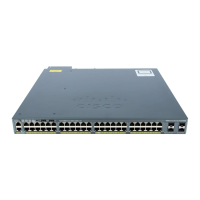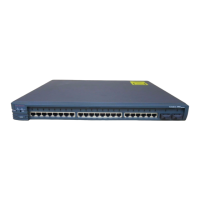When you create an SVI, it does not become active until it is associated with a physical
port.
Note
When configuring SVIs, you can also configure SVI autostate exclude on a port in the SVI to exclude
that port from being included in determining SVI line-state status.
•
Routed ports: Routed ports are physical ports configured to be in Layer 3 mode by using the no switchport
interface configuration command.
•
Layer 3 EtherChannel ports: EtherChannel interfaces made up of routed ports.
A Layer 3 switch can have an IP address assigned to each routed port and SVI.
There is no defined limit to the number of SVIs and routed ports that can be configured in a switch or in a
switch stack. However, the interrelationship between the number of SVIs and routed ports and the number of
other features being configured might have an impact on CPU usage because of hardware limitations. If the
switch is using its maximum hardware resources, attempts to create a routed port or SVI have these results:
•
If you try to create a new routed port, the switch generates a message that there are not enough resources
to convert the interface to a routed port, and the interface remains as a switchport.
•
If you try to create an extended-range VLAN, an error message is generated, and the extended-range
VLAN is rejected.
•
If the switch is notified by VLAN Trunking Protocol (VTP) of a new VLAN, it sends a message that
there are not enough hardware resources available and shuts down the VLAN. The output of the show
vlan user EXEC command shows the VLAN in a suspended state.
•
If the switch attempts to boot up with a configuration that has more VLANs and routed ports than
hardware can support, the VLANs are created, but the routed ports are shut down, and the switch sends
a message that this was due to insufficient hardware resources.
All Layer 3 interfaces require an IP address to route traffic. This procedure shows how to configure an interface
as a Layer 3 interface and how to assign an IP address to an interface.
If the physical port is in Layer 2 mode (the default), you must enter the no switchport interface
configuration command to put the interface into Layer 3 mode. Entering a no switchport command
disables and then re-enables the interface, which might generate messages on the device to which the
interface is connected. Furthermore, when you put an interface that is in Layer 2 mode into Layer 3 mode,
the previous configuration information related to the affected interface might be lost, and the interface is
returned to its default configuration
Note
How to Configure Interface Characteristics
Configuring Interfaces Procedure
These general instructions apply to all interface configuration processes.
Catalyst 2960-XR Switch Interface and Hardware Component Configuration Guide, Cisco IOS Release 15.0(2)EX1
24 OL-29420-01
Configuring Interface Characteristics
How to Configure Interface Characteristics

